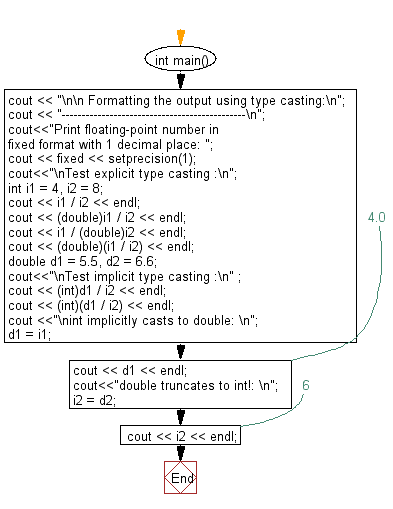C++ Exercises: Test the Type Casting
Test Type Casting in C++
Write a program in C++ to test Type Casting.
Sample Solution:
C++ Code :
#include <iostream> // Including the input-output stream header file
#include <iomanip> // Including the header file for input-output manipulators
using namespace std; // Using the standard namespace
int main() // Start of the main function
{
// Outputting a message indicating the purpose of the program
cout << "\n\n Formatting the output using type casting:\n";
cout << "----------------------------------------------\n";
cout << "Print floating-point number in fixed format with 1 decimal place: "; // Outputting a message
cout << fixed << setprecision(1); // Setting the floating-point number to display with 1 decimal place
cout << "\nTest explicit type casting :\n"; // Outputting a message for explicit type casting
int i1 = 4, i2 = 8; // Initializing two integer variables
cout << i1 / i2 << endl; // Outputting the result of integer division
cout << (double)i1 / i2 << endl; // Explicitly casting i1 to double before division
cout << i1 / (double)i2 << endl; // Explicitly casting i2 to double before division
cout << (double)(i1 / i2) << endl; // Casting the result of the integer division to double
double d1 = 5.5, d2 = 6.6; // Initializing two double variables
cout << "\nTest implicit type casting :\n"; // Outputting a message for implicit type casting
cout << (int)d1 / i2 << endl; // Implicitly casting d1 to int before division with i2
cout << (int)(d1 / i2) << endl; // Casting the result of d1 divided by i2 to int
cout << "\nint implicitly casts to double: \n";
d1 = i1; // Implicitly casting integer i1 to double d1
cout << d1 << endl; // Outputting the value of d1 after casting (implicit type casting)
cout << "double truncates to int!: \n";
i2 = d2; // Implicitly casting double d2 to int i2
cout << i2 << endl; // Outputting the value of i2 after casting (implicit type casting)
return 0; // Returning 0 to indicate successful program execution
}
Sample Output:
Formatting the output using type casting:
----------------------------------------------
Print floating-point number in fixed format with 1 decimal place:
Test explicit type casting :
0
0.5
0.5
0.0
Test implict type casting :
0
0
int implicitly casts to double:
4.0
double truncates to int!:
6
Flowchart:

For more Practice: Solve these Related Problems:
- Write a C++ program to demonstrate both implicit and explicit type casting between int, float, and double.
- Write a C++ program that casts a floating-point number to an integer and then back to a float, displaying each conversion.
- Write a C++ program to perform type casting in arithmetic operations and display how the results differ with each cast.
- Write a C++ program that uses a user-defined function to cast between different numeric types and prints the results with precision formatting.
Go to:
PREV : Compute Specified Expression.
NEXT : Print Mystery Series 1 to 50.
C++ Code Editor:
Have another way to solve this solution? Contribute your code (and comments) through Disqus.
What is the difficulty level of this exercise?
